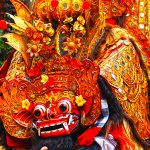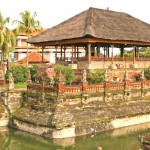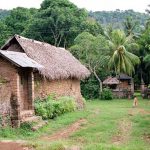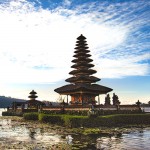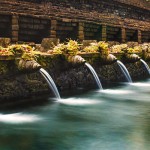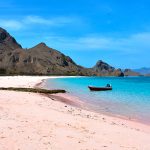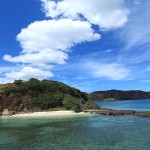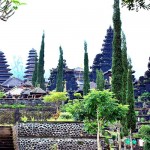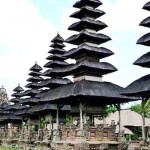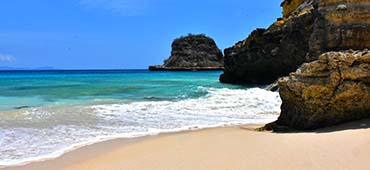Komodo Dragon, the biggest living Lizard on Earth. Komodo Dragon is the largest land reptile in the world with average length 2-3 meters. This large size is related to the symptoms of island gigantism, namely the tendency of the body to behave certain animals that live on small islands associated with the absence of carnivorous mammals on the island where dragons live, and a small metabolic rate of dragons. Because of their size, these lizards occupy the top predator position that dominates the ecosystem in which they live.
This animal is called “ORA” by the locals and is an endangered animal because these animals are endemic animals. Endemic means this animal only lives in certain areas. Komodo Dragon only lives on an island called Komodo Island, Indonesia. Komodo dragons including carnivorous animals, these animals have a rather elongated tongue shape and are forked at the tip like a snake’s tongue. Research shows that the tip of the forked tongue serves to “taste” its food. These animals usually make nests underground.
Komodo dragons are very unique animals because they have two ways to reproduce. First, by mating (fertilization) between male dragons and female dragons. This method is a way of sexual reproduction. The second way is through “Parthenogenesis”. This method makes the female dragons become pregnant without going through the process of fertilization. However, “parthenogenesis” causes all eggs born through “parthenogenesis” to become always male dragons. “Parthenogenesis” is thought to function to prevent the extinction of dragons.

Many people say, the Komodo dragon is a species of Dinosaur. This can be proven by the discovery of fossils from certain types of Dinosaurs that show the similarity of body structure to dragons. It is estimated that dragons are one of a variety of “living fossils” and historical witnesses to the extinction of Dinosaurs. If this is true, perhaps, it is the reproductive system of parthenogenesis that has caused this species to survive. Now, the population of dragons is very small, and this species has been recorded as one of hundreds of endangered animal species.
KOMODO DRAGON : Anatomy and Morphology
In the wild life, the weight of adult Komodo dragons are normally about 70 kilograms and the largest wild species that ever existed had a length of 3.13 meters and a weight of around 166 kilograms, including the weight of undigested food in its stomach. Although the Komodo dragon is recorded as the largest lizard that is still alive, but not the longest. This reputation is held by the Papua monitor lizard (Varanus salvadorii). Komodo has a tail that is the same length as its body, and about 60 teeth with sharp jags along about 2.5 cm, which are often replaced. Komodo dragon’s saliva is often mixed with a little blood because its teeth are almost completely covered by gingival tissue and this tissue is torn during eating. This condition creates an ideal growth environment for deadly bacteria that live in their mouths. Komodo has a long tongue, yellow and forked. The male Komodo dragon is bigger than the female Komodo dragon, with skin color from dark gray to brick red, while the female Komodo dragon is more olive green, and has a small yellow stripe on its throat. Young Komodo dragons are more colorful, with yellow, green and white on a black background.

Komodo does not have the sense of hearing, although it has ear holes. These lizards are able to see as far as 300 m, but because the retina only has cone cells, this animal seems not so good at seeing in the dark of the night. Komodo dragons are able to distinguish colors but are not able to distinguish immovable objects. The Komodo dragon uses its tongue to detect taste and smell stimuli, like other reptiles, with the vomeronasal senses utilizing Jacobson’s organs, an ability that can help navigation in the dark. With the help of the wind and its habit of tilting its head to the right and left when walking, Komodo dragons can detect the presence of carcasses as far as 4-9.5 kilometers. Komodo nostrils are not a good olfactory device because they do not have bulkhead cavity. This animal has no sense of taste on its tongue, there are only a few nerve endings in the back of the throat. Komodo scales, some of which are reinforced with bones, have sensors connected to nerves that facilitate touch excitement. The scales around the ears, lips, chin and footprints have three or more sensory stimuli. Komodo dragons were once deaf when research found that whispers, increased voices and shouts did not result in agitation (disturbance) on wild dragons. This was later denied when the London ZSL employee, Joan Proctor trained lizards to go out to eat with his voice, even when he was not seen by the monitor lizard.

Komodo dragons are only naturally found in Indonesia, on the islands of Komodo, Flores and Rinca and several other islands in Nusa Tenggara. Living in open dry grasslands, savannah and tropical forests at low altitudes, this monitor lizard likes this hot and dry place. They are active during the day, although sometimes also active at night. Komodo dragons are solitary animals, gathering together only when eating and breeding. This large reptile can run fast up to 20 kilometers per hour at short distances; swim very well and be able to dive as deep as 4.5 meters; and good at climbing trees using their strong claws. To catch prey that is outside its range, the Komodo dragon can stand on its hind legs and use its tail as a support. With increasing age, more dragons use their claws as weapons, because of their large size makes it difficult to climb trees.
For shelter, dragons dig holes 1-3 meters wide with front legs and strong claws. Because of the size of the body and the habit of sleeping in the hole, the Komodo dragon can maintain body heat during the night and reduce the amount of time to sunbathe the next morning. Komodo dragons generally hunt in the afternoon until the afternoon, but still take shelter during the hottest part of the day. The Komodo dragon’s hiding places are usually in areas of dunes or hills with sea breezes, open from vegetation, and scattered here and there with the dung of the inhabitants. This place is generally also a strategic location for ambushing deer. Komodo dragons are carnivorous animals. Although they mostly eat carcass meat, research shows that they also hunt live prey by sneaking followed by a sudden attack on their victims. When the prey arrives near the Komodo dragon’s hiding place, it immediately attacks it on the underside of the body or throat. Komodo dragons can find their prey by using their keen sense of smell, which can find dead or dying animals at distances of up to 9.5 kilometers.
KOMODO ISLAND
Komodo Island is an island located in the Nusa Tenggara Islands. Komodo Island is known as a habitat for native animals; Komodo Dragons. The Komodo island is part of the Komodo National Park which is managed by the Central Government. Komodo Island is located east of Sumbawa Island, separated by the Sape Strait. Administratively, this island including the District of Komodo, West Manggarai regency, East Nusa Tenggara Province, Indonesia. Komodo Island is the westernmost tip of Nusa Tenggara Timur province, bordering the province of West Nusa Tenggara.

On the island of Komodo lives the Komodo Dragons and breed well. Until August 2009, there are about 1,300 dragons living on this island. Coupled with the other islands, like the island of Rinca and Gili Mota, their numbers totaled about 2500. Besides Komodo dragons, the island also has a diverse exotic flora of Sepang wood (The locals called it Nitak Tree) which is used by local residents as medicine and clothing coloring raw materials. This Nitak tree or Sterculia oblongata is believed to be useful as medicine and its fruit seeds are tasty like peas. Komodo Island is also accepted as a UNESCO World Heritage Site, because it is in the Komodo National Park area, along with Rinca Island, Padar Island and Gili Motang.
KOMODO NATIONAL PARK
Komodo National Park is a national park in Indonesia located within the Lesser Sunda Islands in the border region between the provinces of East Nusa Tenggara and West Nusa Tenggara. The park includes the three larger islands Komodo, Padar and Rinca, and 26 smaller ones, with a total area of 1,733 km2 (603 km2 of its land). The national park was founded in 1980 to protect the Komodo dragon, the world’s largest lizard. Later it was dedicated to protecting other species, including marine species. In 1991 the national park was declared a UNESCO World Heritage Site.
Komodo National Park has been selected as one of the New7Wonders of Nature. The waters surrounding Komodo island contain rich marine biodiversity. Komodo islands is also a part of the Coral Triangle, which contains some of the richest marine biodiversity on Earth.

History
Komodo National Park was established in 1980. It was declared as a World Heritage Site and Men’s Biosphere Reserve by UNESCO in 1991. The park was initially established to conserve the unique Komodo dragon (Varanus komodoensis), first discovered by the scientific world in 1912, Lieutenant J. K. H. van Steyn van Henbroek, the Civil Administrator in Reo, Flores Island. Since then, the conservation goals have expanded to protecting the entire biodiversity of the region, both marine and terrestrial.
The majority of the people in and around the park are fishermen originally from Bima (Sumbawa), Manggarai, South Flores, and South Sulawesi. Those from South Sulawesi are from the Suku Bajau or Bugis ethnic groups. The Suku Bajau were originally nomadic and moved from location to location in the region of Sulawesi, Nusa Tenggara and Maluku, to make their livelihoods. Descendants of the original people of Komodo, the Ata Modo, still live in Komodo, but there are no pure blood people left and their culture and language is slowly being integrated with the recent migrants.
Geography and climate
The rugged terrain of Komodo Island with few trees makes it one of the driest locations in Indonesia. The park comprises a coastal section of western Flores, the three larger islands of Komodo, Padar and Rinca, 26 smaller islands and the surrounding waters of the Sape Straights. The islands of the national park are of volcanic origin. The terrain is generally rugged, characterized by rounded hills, with altitudes up to 735 m. The climate is one of the driest of Indonesia with annual rainfall between 800mm and 1000mm. Harsh daily temperatures in the dry season from May to October are around 40 °C.
Flora and fauna
The hot and dry climate of the park, characterized by savannah vegetation, makes it a good habitat for the endemic Komodo dragon (Varanus komodoensis). Their populations are restricted to the islands of Komodo (1,700), Rinca (1,300), Gili Motang (100), Gili Dasami (100), and Flores (c. 2,000), while extinct on Padar. Cloud forests appear only in few areas above 500 metres but they provide habitat to several endemic flora. Coastal vegetation includes mangrove forest, which generally appear in the sheltered bays of the three larger islands.
Fringing and patch coral reefs are extensive and best developed on the north-east coast of Komodo. The park is rich in marine life, including whale sharks, ocean sunfish, manta rays, eagle rays, pygmy seahorse, false pipefish, clown frogfish, nudibranchs, blue-ringed octopus, sponges, tunicates, and coral. Varieties of cetaceans inhabit in adjacent waters from smaller sized dolphins to sperm whales and even blue whales. Omura’s whales, one of the least known of rorquals have been confirmed to range waters within the park. Endangered dugongs still live in Komodo areas as well.

The terrestrial fauna is of rather poor diversity in comparison to the marine fauna. The number of terrestrial animal species found in the park is not high, but the area is important from a conservation perspective as some species are endemic. Many of the mammals are Asiatic in origin Including the Timor deer, wild boar, water buffalo, crab eating macaques and civet. Several of the reptiles and birds are Australian in origin. These include the orange-footed scrubfowl, the lesser sulpher crested cockatoo, and the helmeted friarbird.
The most famous of Komodo National Park’s reptiles is the Komodo dragon (Varanus komodoensis). It is the world’s largest lizard and is among the world’s largest reptiles and can reach 3m or more in length and weigh over 70 kg.
Twelve terrestrial snake species are found on the island in addition to marine species. Snakes include the Javan spitting cobra (Naja sputatrix), Russell’s viper (Daboia russelii), white-lipped pit viper (Trimeresurus albolabris), blue lipped sea krait (Laticauda laticaudata), and Timor python (Python timoriensis). Lizards include nine skink species (Scinidae), geckos (Gekkonidae), limbless lizards (Dibamidae), and the monitor lizards such as the Komodo dragon (Varanidae). Frogs include the Asian bullfrog (Kaloula baleata), the endemic Komodo cross frog (Oreophryne jeffersoniana) and Oreophryne darewskyi. Frogs are typically found at higher, moister altitudes. The saltwater crocodile (Crocodylus porosus) was once present within the park in coastal areas including mangrove swamps but is now extinct within the area.
Mammals found within the park include the Timor rusa deer (Cervus timorensis), the main prey of the Komodo dragon, horses (Equus sp.), water buffalo (Bubalus bubalis), wild boar (Sus scrofa vittatus), crab-eating macaque (Macaca fascicularis), Asian palm civet (Paradoxurus hermaphroditus lehmanni), the endemic Rinca rat (Rattus rintjanus), and fruit bats. Domestic mammals on within the park include goats, cats and dogs which are feral.
One of the main bird species is the orange-footed scrubfowl (Megapodius reinwardti), a ground dwelling bird. In areas of savanna, 27 species were observed. The zebra dove (Geopelia striata) and spotted dove (Spilopelia chinensis) were the most common species. In mixed tropical deciduous habitat, 28 bird species were observed, and helmeted friarbird (Philemon buceroides), green imperial pigeon (Ducula aenea), and lemon-bellied white-eye (Zosterops chloris) were the most common. Other birds include vibrantly coloured species such as green junglefowl (Gallus varius), great-billed parrot (Tanygnathus megalorynchos), and the critically endangered lesser sulpher crested cockatoo (Cacatua sulphurea). Two eagle species are found in the park, the white-bellied sea eagle and the extremely rare Flores hawk-eagle which is present on Rinca and Flores and reported but unconfirmed on Komodo Island.
How to Explore Komodo National Park?
The Main access to get to Komodo National Park is from Labuan Bajo, West Flores by local wooden boats or speedboat, while there are daily flights from Bali, Jakarta or Surabaya to Labuan Bajo. It is not recommended to arrange Komodo Tours on spot since the Boats need to prepare things such as Meals and other equipment before leaving the harbor. Besides Komodo Dragon, the waters surrounding Komodo island contain rich marine biodiversity, You can do Komodo Live-aboard Tour for multiple days to explore the Terrestrial and Marine life of Komodo National Park.
When is the best time to visit Komodo National Park?
The best time to visit Komodo National Park is between April and December during the dry season. The weather is very nice, not too hot with very little to no rain. The rainy season sometimes starts early in December, so if you don’t like getting wet plan your trip before. You can spot the Komodo dragon all year round.
How to plan a trip to Komodo National Park?
if you’re thinking about how to plan trip to Komodo and Flores Island, that means you have planned a trip to Indonesia! That’s double-awesome because there’s definitely a ton of things to do and see along the way. So, you need to get to Indonesia and then get to Komodo Island, mostly the visitors get to Komodo and Flores Island from Bali as it is easy to get to Komodo island from Bali.
Once you get to Bali (Denpasar), we recommend you to have one day or two days rest of jet lack, or it is also recommended to have more days to enjoy and explore Bali Island before leaving for Komodo and Flores Island. Definitely do that and make sure you check to see when and how much the flights are from Bali to the airport closest to Komodo Island; Labuan Bajo.
The most important things when you start planning your trip to Komodo Island is; first need to think about time. The best time to visit the Komodo National Park is during the dry season, from April to December. You can trek in the park and see the Komodo dragons all year around, although between July to August and September to November the dragons are less active due to the mating and nesting seasons. I was there in July, the weather was perfect, hot, sunny, and we got to see some dragons, overall it was a great experience even being during a quiet month.
Second important question: how long should be your trip to Komodo Island? You can spend two days and a half in the park and it is enough to enjoy the top attractions of Komodo National Park. I would say to do at least a two days trip from Labuan Bajo to the Komodo Islands, then one more day to relax. If you are going to the National Park for some serious diving, we suggest staying a bit longer.

